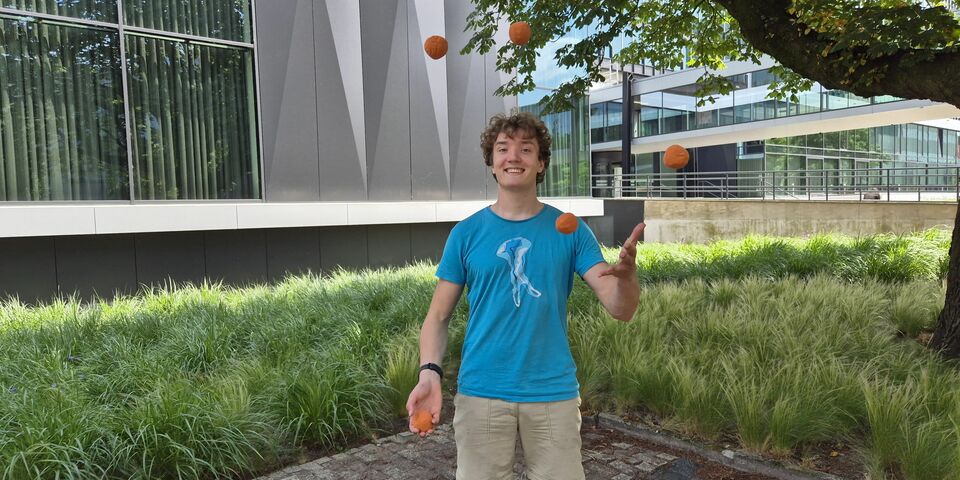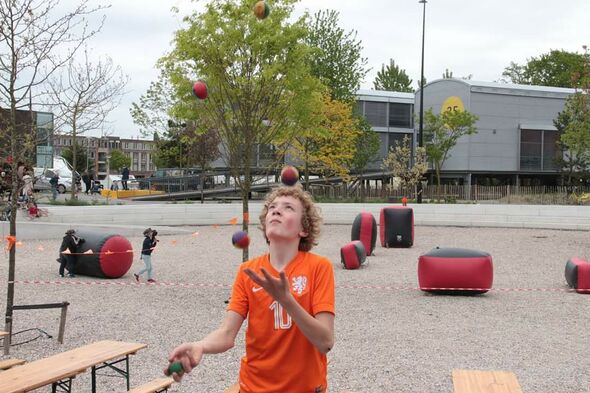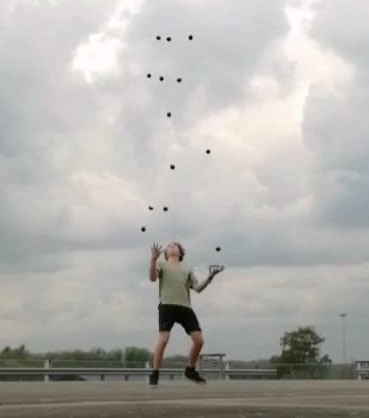Juggler Karel Schuller: from parade to global performer
Eight years ago, he had never even tried juggling, but today, Industrial Design student Karel Schuller ranks among the world’s elite in numbers juggling. He can throw and catch 12 balls, a feat that only twenty people worldwide can match. Cursor happened to see him practicing and asked him how he got to this level of skill.
The reason why Schuller took up juggling is pretty funny. “I wanted to be a juggler in the Sinterklaas parade.” In 2017, he had just started at Circus Amersfoort. After discovering that gymnastics and ice skating were not really his thing, his parents let him try out this unique sports club. It was love at first sight, and the thirteen-year-old set himself a goal: to become so good at juggling that he could join the circus school’s parade in December.
Juggling involves throwing objects into the air and catching them again. You can do this with balls, pins, rings, or more dangerous objects such as knives and chainsaws. There are various specializations, and Schuller explains two of them: numbers juggling and siteswap. Both require coordination, concentration, and a sense of rhythm.
“Numbers juggling is about making as many catches as possible with as many objects as possible in the standard juggling patterns. Siteswap focuses on the technical performance. You use mathematical patterns and precise timing. The notation system for these patterns is also called siteswap, by the way. You write down the throw height for each object. So 5,3,1 or 7,4,4.” The numbers refer to the relative height in relation to the other throws.
Schuller practices numbers juggling and chooses to work with balls for practical reasons. Since he is currently training for a 13-ball flash (we’ll explain that in a bit), it makes sense that they should fit in his backpack. He enjoys practicing outdoors in his free time, before or after his Industrial Design study sessions. If you look outside from the stairwell in Atlas, or if you’re outside yourself, there is a good chance that you might spot him throwing and catching between Atlas and the Auditorium.
A flash is a series of throws and catches in equal numbers. If you can throw and catch three balls in one fluid motion, you have reached the milestone known as a “3-ball flash”. If you can keep it up for twice as long, that’s called a qualify.
Don't give up
Let’s go back to Amersfoort for a moment; Schuller didn’t stop once he had achieved his goal of juggling in the parade. “Three years later, I flashed 11 balls.” He says that every milestone feels like a combination of relief and joy. “You have to do the same thing over and over again, and most of the time it doesn’t work, until suddenly, it does. I practiced for two and a half years for the 12-ball flash. Now, if I want to, I can do it every training session.”
In the Netherlands, there are two people registered as being able to do the 12-ball flash. The other is Simon á Campo, who also happens to be an industrial Designer. He graduated in 2018. They know each other from the juggling scene. “Simon could do the 12-ball flash five years before I could, but I can now do it one throw longer.” Thirteen catches doesn’t count as a qualify, but it’s definitely something to be proud of.
“A rough rule of thumb is that a qualify with a certain number of balls is about as difficult as a flash with two extra balls, but that rule certainly doesn’t apply to everyone and in every situation,” explains Schuller. “For example, I haven’t been able to do a 10-ball qualify yet, but I’m getting close.”
World records
Schuller has a few other juggling achievements to his name as well. He shows an online list detailing several world records attributed to him. These are: 11 balls on a rola bola (a balance board placed loosely on a cylinder), 10 balls on a unicycle, and 10 balls on a walking globe (a large circus ball).
Schuller is currently walking with crutches. I injured my ankle the first time I tried skateboarding at Area 51,” he explains. It’s a little ironic that he can juggle on a rola bola but still fell off a skateboard. “Just a case of bad luck.”
Tips
Cursor is not the only one who has approached Schuller when he is outside practicing his juggling. “Usually, people say they can’t even juggle two balls, or they ask me for tips.” According to him, the most important tip is not to practice for a long time at once, but to practice more often in shorter sessions. “It’s better to practice three minutes every day than one hour once a week.” He also recommends watching tutorial videos on YouTube and going to festivals. Luckily, that’s easy this summer, see text box.
Papendal
Each year, the European Juggling Convention (EJC) takes place, where juggling enthusiasts come together. This is the largest juggling event in the world, with around 5,000 participants expected. Schuller has already attended three editions – in Portugal, Spain and Poland. This summer, he won’t have to travel far, and he will help organize the competitions.
The EJC will take place in Papendal from August 3 to 9. There will be workshops, shows, tournaments, and even a scientific experiment conducted by Georg Blanke, a PhD candidate at the German Chemnitz University of Technology. He will be examining, on site, the human ability to synchronize rhythmic patterns in perception and action. To do so, he will enlist the help of adult volunteers who can perform a 5-ball flash.





Discussion